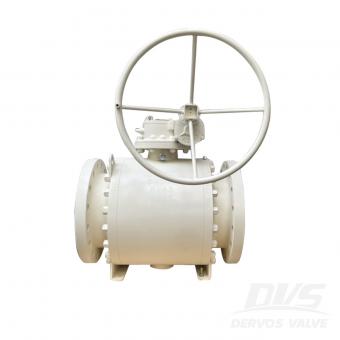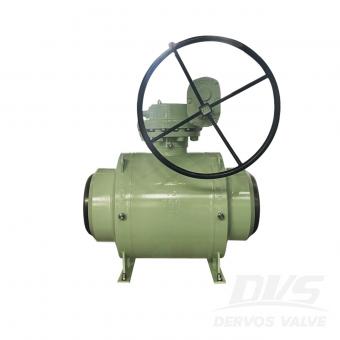16" x 12" 600LB trunnion mounted ball valve is made according to API6D standard. The valve body is made of A105. It has the structural characteristics of split type, side mounted, fixed ball, reduced diameter. Its connection mode is RF. And it has pneumatic operation mode.
16" 150LB double eccentric butterfly valve twins are made according to API 609 standard. The valve body is made of ASTM A216 WCB. It has the structural characteristics of high performance and dual eccentricity. Two valves share one worm gear head. Its connection mode is wafer. And it has turbine operation mode.
1" 300LB steam trap valve is made according to GB/T22654-2008 standard. The valve body is made of LF2 CL1. It has the structural characteristics of thermodynamic type. Its connection mode is RF.
2" 300LB change over valve is made according to ASME B16.34 standard. The valve body is made of ASTM A216 WCB. It has the structural characteristics of plug cover, the overall internal material is F316L. Its connection mode is RF. And it has Handwheel operation mode.
12" 1500LB cast steel slab gate valve is made according to API 6D standard. The valve body is made of A216 WCB. It has the structural characteristics of body cover bolt, full flow, cleanable pipe, anti-fire design. Its connection mode is RTJ. And it has gearbox operation mode.
DN200 PN16 angle bellows sealed globe valve is made according to BS EN 13709 standard. The valve body is made of EN 10213 1.4408. It has the structural characteristics of body cover bolt, exposed pole bracket, angle type, bellow seal. Its connection mode is RF. And it has hand wheel operation mode.

DN300 PN63 ball valve is made according to API 6D standard. The valve body is made of ASTM A105. It has the structural characteristics of fixed ball, full bore, anti-fire, anti-static, and anti-flying valve stem. Its connection mode is EN1092-1 D. And it has worm wheel operation mode.

16" 900LB ball valve is made according to API 6D standard. The valve body is made of A350 LF2. It has the structural characteristics of fully welded, fixed ball and full bore. Its connection mode is BW. And it has turbine operation mode.

In industrial piping systems, globe valves and gate valves are two of the most commonly used shutdown valves. Although both are designed for starting and stopping fluid flow, they differ significantly in structural design, operating principles, application scenarios, and overall performance. Understanding these differences helps engineers make informed selections that ensure system efficiency, reliability, and cost-effectiveness. I. Key Differences in Structure and Operating Principles 1. Different opening and closing mechanisms Globe Valve: The disc moves up and down along a path perpendicular to the flow direction. Shutoff is achieved when the disc and seat sealing surfaces come into full contact. Gate Valve: The gate moves vertically in a manner similar to a “gate” that is either fully open or fully closed, with sealing achieved through surface compression. This means that globe valves are suitable for precise throttling, while gate valves are mainly used for full open or full shut service. 2. Flow path design differences A globe valve has an S-shaped flow path that forces the medium to change direction, resulting in higher flow resistance. A gate valve features a straight-through flow path with minimal resistance and low pressure drop, making it better suited for long-distance transmission. II. Differences in Application Scenarios 1. Throttling vs. On/Off Service Globe valves can be used for throttling and flow regulation, making them suitable for applications requiring high sealing performance and precise flow control, such as steam, cooling water, and various process media. Gate valves are not suitable for throttling, as operating them in a partially open position may cause gate vibration, damage to the sealing surfaces, and fluid-induced impact. Gate valves are ideal for large-diameter pipelines where low flow resistance is required and switching frequency is relatively low, including oil transportation, water supply and drainage, and power plant systems. 2. Size range and installation space Globe valves are generally used in small to medium sizes (more common below DN50). Their body structure is heavier and requires more installation space. Gate valves are suitable for medium to large sizes. Due to their simpler design, they offer a cost advantage in larger dimensions. III. Sealing Performance and Pressure Ratings 1. Differences in sealing surface design The globe valve features a tapered sealing surface, which achieves tight shutoff through axial compression, making it easier to obtain reliable sealing performance. The gate valve uses either parallel or wedge-type sealing surfaces. Its sealing effectiveness depends largely on the pressure applied by the gate and is more influenced by the system’s medium pressure. 2. Pressure and temperature adaptability Both valve types are suitable for medium- to high-pressure and high-temperature applications....

Butterfly valves are widely used in industrial piping systems due to their compact structure, lightweight design, and quick operation. They are commonly applied in water treatment, chemical, power, oil, and gas industries. However, when dealing with industrial standards across different countries and regions, selecting a butterfly valve that meets the relevant specifications is crucial. This article provides a detailed analysis of butterfly valve design and selection requirements based on three key standards: API 609, ISO 5752, and GB/T 12238. 1. API 609 — American Petroleum Institute Standard API 609 is the American Petroleum Institute (API) standard for metal-seated butterfly valves, primarily used in the oil, gas, and chemical industries. The standard defines valve structure, materials, dimensions, and pressure ratings to ensure reliable performance under high temperature, high pressure, and corrosive media conditions. Key points include: ● Pressure Ratings: Covers Class 150 to 1500, accommodating various service conditions. ● Body and Disc Design: Metal-to-metal sealing requires precise alignment between disc and seat to prevent leakage under high temperature or high pressure. ● Testing and Inspection: Includes shell tests, seat leakage tests, and operational performance checks to ensure valve safety and reliability. For high-temperature steam or high-pressure oil and gas pipelines, selecting a butterfly valve compliant with API 609 can significantly reduce leakage risk and extend equipment lifespan. 2. ISO 5752 — International Standard Organization Standard ISO 5752 is the International Organization for Standardization (ISO) standard that specifies end dimensions and flange connection sizes for valves. It defines the face-to-face dimensions, flange sizes, and connection methods for butterfly valves, providing a consistent interface specification for industrial users worldwide. Key points include: ● Face-to-Face Dimensions: Specifies valve lengths for different nominal diameters to ensure compatibility with piping systems. ● Flange Dimensions: Ensures valves match international standard pipe fittings, such as ANSI or DIN flanges. ● Interchangeability: Butterfly valves designed according to ISO 5752 can be replaced or serviced globally without redesigning the pipeline interface. ISO 5752 is particularly suitable for multinational engineering projects, ensuring the universality of butterfly valves across different plants and systems. 3. JB/T8527 — Chinese National Standard JB/T8527 is the Chinese national standard specifying the dimensions, structure, and testing requirements for metal hard-seal butterfly valves. It is widely applied in domestic industrial projects such as water conservancy, power, and petrochemical industries, serving as an important reference for procurement and acceptance. Key ...

Check valves are often considered the most “quiet” yet essential components in a piping system. Their primary function is to prevent backflow and safeguard pumps, compressors, and the overall stability of the system. However, in real-world applications, poor sealing—commonly referred to as “leakage”—is one of the most frequent and frustrating issues encountered in check valve operation. When a check valve fails to seal properly, it can reduce system efficiency, trigger pressure fluctuations, cause water hammer, and even damage critical equipment. This article breaks down the technical causes behind check valve leakage and offers practical diagnostic and corrective measures to help you quickly identify and resolve sealing problems, even under challenging operating. 1. Why Does a Check Valve Fail to Close Properly? Common Causes Explained 1. Presence of Particles or Solid Impurities in the Medium Solid particles can become trapped between the disc and the seat, preventing full contact and causing slight or even noticeable leakage. Typical signs include: ● Significant leakage at small opening positions ● Leakage decreases after cleaning 2. Disc Wear or Seat Damage Frequent cycling, corrosive media, or high-velocity flow can wear the sealing surfaces, resulting in scratches, pits, or deformation. This issue is especially common in high-temperature steam systems. 3. Incorrect Installation Direction or Insufficient Tilt Angle Although it may sound like a basic mistake, incorrect installation still occurs on many job sites. Since check valves rely heavily on gravity and flow direction, improper installation prevents the disc from returning to its closed position smoothly. 4. Flow Velocity Too Low to Create Adequate Differential Pressure A check valve opens through fluid flow. When the flow rate is too low, the disc may flutter or fail to close completely, leading to leakage. Common scenarios include: ● Insufficient straight-pipe length ● Frequent pump start/stop ● Poorly designed low-flow systems 5. Disc Sticking or Hinge Mechanism Not Operating Smoothly In swing check valves, rust, corrosion, or lack of lubrication at the hinge pin or disc connection may cause sticking, preventing full closure. 6. Thermal Deformation of Sealing Surfaces Due to Temperature Fluctuations In high-temperature conditions such as steam service, thermal expansion and contraction can slightly deform sealing surfaces, resulting in an imperfect seal. 2. How to Quickly Determine If a Check Valve Is Not Closing Properly? 1. Abnormal Pressure Gauge Readings If the inlet pressure remains stable while the outlet pressure gradually rises, backflow caused by check-valve leakage is the most likely reason. 2. Pipe Vibration or Light Knocking Sounds This indicates that the disc is oscillating at high frequency, often due to insufficient flow velocity or a loose dis...
If you are interested in our products and want to know more details,please leave a message here,we will reply you as soon as we can.
"Everything is perfectly made. We are grateful for the confidence you are showing in our organization and fully trust our hard-work will be fruitful for both of our companies. You are truly a GEM for Dervos Valves. Our best compliments to you!"
"Your customer service is outstanding. ... ... The check valves works fine and the customer service certainly makes up for it. ... ... The customer service couldn’t be better."
"We are very satisfied with all your kind business supports. You are always kindly answering all our questions. So, we thank you for all your efforts. When we have any new project, we will readily make a contact with you!"
"I’ve received your document today. Thank you so much. Our engineer says your report seems to have been done quite well, he appreciated, of course we haven’t got the vannes so we haven’t had a check, but I believe there won’t be problem, hope so."
"Thank you for engaging with our organisation regarding Dervos. We place various orders with Dervos and products were always completed ex-factory, to drawing and within the time periods indicated. Dervos is a very proud company and place huge emphasis in delivering quality products to their customers."